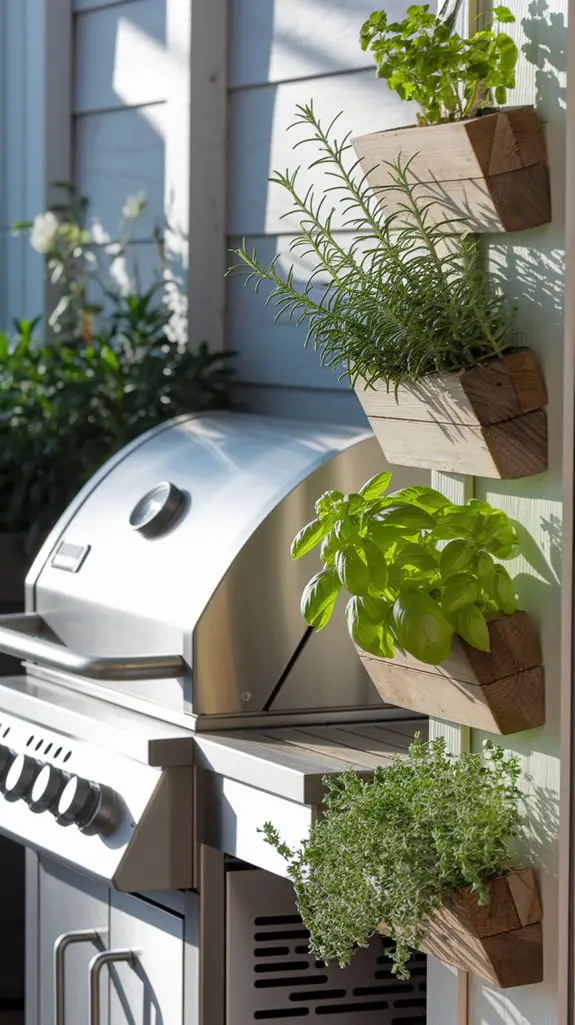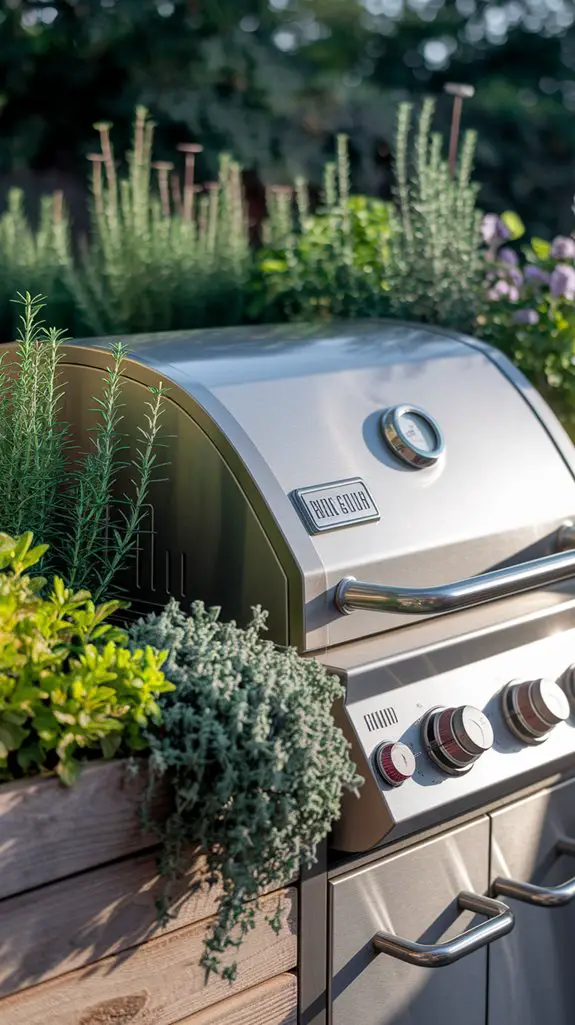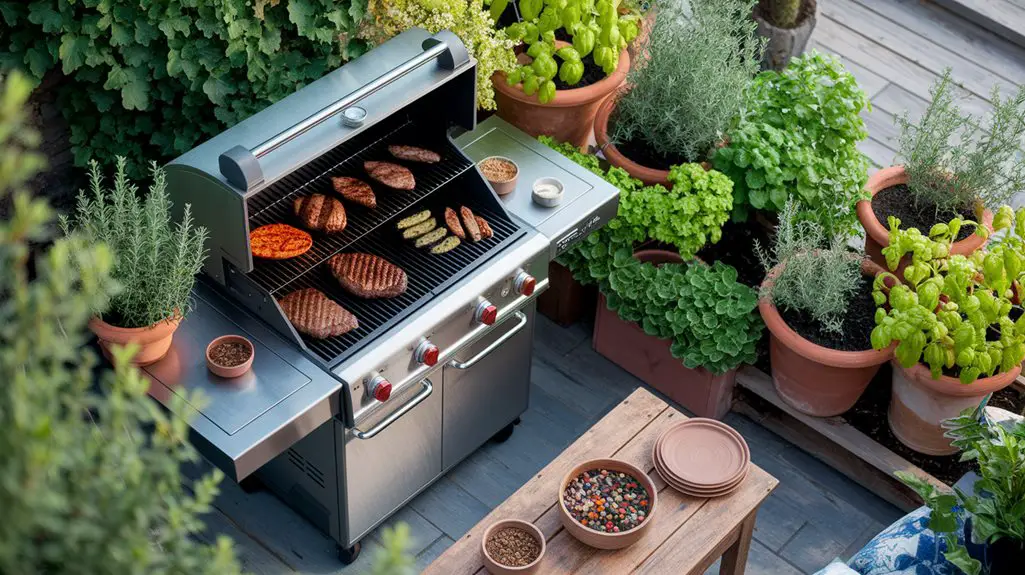Just as summer arrives, you’ve likely noticed your BBQ grill and herb garden sitting side by side—yet never truly working together. Combining these outdoor elements creates a seamless cooking experience that elevates your grilling game. You’ll discover how purpose-built herb gardens near your grill station can transform weekend cookouts with fresh flavors at your fingertips. The marriage of fire and herbs isn’t just convenient; it’s the secret weapon of seasoned outdoor chefs.
Designing Adjacent Herb Beds for Your Grill Station
When designing adjacent herb beds for your grill station, consider both accessibility and practicality to guarantee your fresh herbs are within arm’s reach while cooking.
Choose a location that receives 6-8 hours of sunlight daily but won’t overheat from grill proximity. Build raised beds 2-3 feet high to eliminate bending while grilling.
Organize herbs by water requirements—group Mediterranean varieties like rosemary, thyme and oregano together in well-draining soil. Essential herbs can enhance the flavors of your grilled dishes and should be prioritized in your garden.
Include dedicated sections for tall herbs (rosemary, sage) and spreading varieties (mint) with root barriers. Install drip irrigation with separate zones for different watering needs.
For convenience, incorporate a small cutting board and scissor storage directly into your design.
Use weather-resistant labels to identify each plant, especially for similar-looking herbs like different basil varieties.
Space-Saving Vertical Herb Gardens for Compact BBQ Areas

Vertical herb gardens offer the perfect solution for grill enthusiasts working with limited outdoor space. Mount a wooden pallet on your patio wall, add soil-filled pouches in each slat, and plant compact herbs like thyme, rosemary, and oregano.
For even tighter spaces, consider tiered hanging planters that suspend from overhead structures, maximizing vertical real estate while keeping aromatic herbs within arm’s reach of your grill station.
Repurposed gutters attached horizontally to nearby railings provide another efficient option. Install them in staggered rows with proper drainage holes and fill with culinary herbs that thrive in shallow soil.
For ultimate convenience, integrate mason jar herb gardens directly onto your grill cart using hose clamps, creating a mobile culinary resource that doesn’t sacrifice precious square footage. Additionally, vegetable gardening in backyard containers allows you to cultivate fresh ingredients right at your fingertips, enhancing your BBQ experience.
Selecting Heat-Tolerant Herbs for Grillside Planting

Why settle for herbs that wilt under the intense heat of your grill area? Select varieties specifically adapted to withstand high temperatures and occasional smoke exposure.
Mediterranean herbs like rosemary, thyme, and sage thrive in these conditions due to their woody stems and drought-resistant properties. Oregano and marjoram also perform exceptionally well, offering robust flavors that complement grilled meats.
When positioning heat-tolerant herbs, consider lavender and Mexican tarragon for areas receiving direct heat radiation, as their natural oils provide added protection.
Chives and garlic chives can withstand temperature fluctuations while providing quick garnishes for finished dishes. For ideal growth, plant these hardy herbs in well-draining soil with minimal organic matter – excessive richness actually reduces their essential oil concentration and flavor intensity. Additionally, incorporating well-draining soil is essential for preventing root rot and promoting healthy growth.
Monitor moisture levels carefully; most heat-tolerant herbs prefer drying slightly between waterings.
Built-In Herb Planters for Custom Grill Islands
Custom grill islands transform dramatically when you incorporate strategically designed herb planters into their structure.
Position these planters at 24-30 inches in height—ideal for quick harvesting while cooking. Consider L-shaped configurations with herbs positioned on the outer edge, keeping them accessible but away from direct heat exposure.
Choose materials that complement your island’s design: stainless steel planters offer durability and sleek aesthetics, while natural stone creates a rustic appeal.
Install proper drainage systems with a minimum 1/2-inch slope and filtered outlets to prevent clogging. For ultimate convenience, integrate drip irrigation systems with programmable timers.
When designing dimensions, allow 4-6 inches of soil depth for most culinary herbs.
Incorporating herbs in your garden can also provide educational components for kids to enhance their learning experience.
Separate planters with thermal barriers if positioning near hot zones to protect delicate root systems from excessive heat.
Irrigation Systems for Maintaining Herbs Near Heat Sources
Herbs planted near BBQ grills require specialized irrigation systems to thrive despite the challenging microclimate created by radiant heat.
You’ll need to install drip irrigation with heat-resistant tubing, positioned to deliver water directly to the root zones while avoiding the grill’s hottest areas.
Include a timer-controlled system that waters during cooler morning hours to maximize absorption. Set your irrigation controller to deliver shorter, more frequent cycles rather than infrequent deep soaking. This prevents soil from completely drying out when exposed to grill heat.
Add a moisture sensor that automatically adjusts watering schedules based on ambient conditions.
Install a water-efficient misting system that activates during cooking sessions to create a protective microclimate for your herbs, counteracting the drying effect of your grill’s radiant heat.
Quick-Access Herb Snipping Stations for Grillmasters
The ideal grillmaster needs immediate access to fresh herbs while managing cooking temperatures and timing. Your herb snipping station should be positioned within arm’s reach of your grilling area, yet safely away from direct heat and smoke paths.
Design your station with efficiency as the priority.
- Mount scissors or herb shears on a magnetic strip alongside your grill’s prep surface.
- Install small containers filled with water to keep cut stems fresh during extended cooking sessions.
- Label each herb section clearly with heat-resistant markers or metal tags.
- Incorporate a small cutting board directly into your station design for immediate mincing.
Consider a tiered approach with frequently used herbs (thyme, rosemary) positioned at the most accessible level and specialty herbs slightly further back. Adding a variety of raised bed herb gardens can also enhance your grilling experience by providing an abundant supply of flavors.
Weather Protection Strategies for Year-Round Grillside Herbs
Maintaining vibrant herbs alongside your grill requires strategic protection from weather extremes that can quickly damage delicate plants.
Install clear polycarbonate panels that shield herbs from rain and wind while allowing sunlight penetration. These panels should be positioned 8-12 inches from plants to prevent heat buildup.
For winter protection, consider retractable thermal covers that trap daytime warmth. These covers work best when deployed at sunset and removed by mid-morning. In extreme cold, supplement with soil heating mats (10-15 watts per square foot) placed beneath containers.
During summer heat waves, install 40% shade cloth above herbs positioned near your grill’s heat zone.
Automate protection with temperature-triggered misters that activate at 85°F. Remember to position sensitive herbs like basil and cilantro farthest from direct grill heat. Additionally, regular eco-friendly lawn care practices can help create a healthier environment for your herbs to thrive.
Conclusion
With these seven strategies, you’ll elevate your grilling game while enjoying fresh herbs at your fingertips. While some may worry about maintenance requirements, today’s self-watering planters and drought-resistant varieties minimize upkeep. The investment in a well-designed grillside herb garden pays dividends through enhanced flavor profiles, reduced grocery costs, and the unmatched satisfaction of incorporating freshly harvested aromatics into your outdoor culinary creations.




